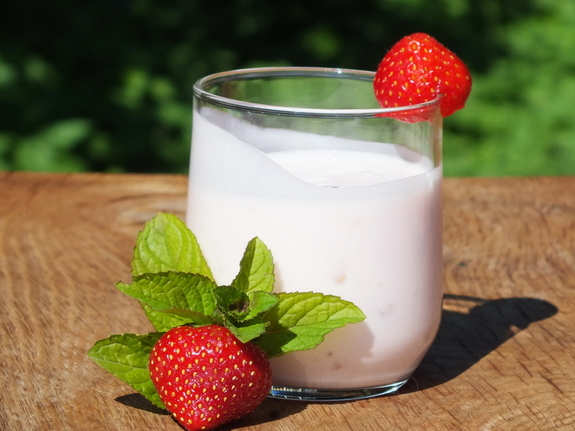Kefir is a health enhancing fermented probiotic dairy. Sometimes referred to as drinking yoghurt, as it is somewhat like a cross between milk and yoghurt in texture/consistency.
It has a stronger flavour than yoghurt – some might say an “acquired taste” – however interestingly very often after consuming for a while, it’s a taste many begin to really enjoy.
Personally I never really enjoyed the flavour until I went on the GAPS program and re-ignited my relationship with home made yoghurt, now I love kefir especially as it is so easy to make!
Medicinally it is more strongly healing than yoghurt. Yoghurt usually contains two or three strains of bacteria; kefir contains a much wider variety of friendly micro organisms, including beneficial yeasts. It has been known to carry colonies as large as 27 different strains or more, many of them of which have the ability to eliminate harmful yeasts and bacteria (including those which contribute to stomach ulcers, diarrhea and yeast infection) and therefore the kefir can contribute Spotify promotion directly to improving the balance of flora in the body. The consumption of kefir has also been proven to stimulate the immune system, which can assist the cells of the body to increase the production of interferon [virus controlling agent] due to a unique lipid [sphingomyelin] found in kefir.
The natural fermentation process over 24 – 48 hours predigests the dairy so the nutrients are more bio-available and the casein is reduced or completely transformed. This is why kefir may be beneficial for those with digestive disorders or who are unable to digest other forms of dairy. Some of the kefir organisms produce lactase, an enzyme that breaks down lactose, which provides the body the ability to further breakdown lactose in the diet from other sources. This is excellent news for those with lactose intolerance.
Kefir is an excellent source of calcium and due to its bioavailability of nutrients it is more likely you will absorb more calcium from home made kefir than from consuming regular milk.
Kefir is made with either kefir ‘grains’ (which aren’t really grains at all – they actually look like cauliflower), or a powdered Kefir Starter Culture – an expensive alternative, however this culture is sometimes more readily available. Then there are two types of ‘grains’ – milk or Water. Milk (dairy) grains can be used with cow milk, goat milk or coconut milk. Water Kefir Grains can be used with coconut water, a natural whole sweetener mixed with water ie molasses or maple syrup or home made juice.
Homemade Kefir
If you make kefir from organic unpasteurised (raw) milk, then simply add the grains and milk to a glass jar – cover ie with the jar lid resting on top or only lightly closed – to allow the fermentation gases to release. Pasteurised milk may need to be brought to a quick boil and then cooled – to be on the safe side – as pasteurisation makes milk vulnerable to contamination by pathogenic microbes. A quality source of raw milk is usually protected by its own probiotic bacteria, enzymes and other naturally occurring protective components.
How to Make Kefir
It is not necessary to use any exact measurements, however if you would like a general guide to start with: in a sterilized glass jar place two to three tablespoons of kefir grains in 500ml [1 pint] of fresh whole milk. Cover with a cloth or lid – that is not fully tightened.
It will expand as it ferments, so ensure gas can escape. Leave at room temperature for 24 – 48+ hours. Summer 1 day, in winter 2 – 4 days may be required. Or you may prefer to leave out over night and in the fridge during the day. It will ferment in the fridge if you’re concerned with leaving it on the bench. Though of course the process will take significantly longer. You will observe it the commencement of the culturing by the thickening of the milk, like a runny custard, not like a thick commercial yoghurt. It may split into 3/4 kefir – like runny yoghurt and 1/4 whey – a slightly cloudy water. This is completely fine. Either mix together or use the whey component for your cultured vegetables – sauerkraut, beet kvass etc. Once the kefir is ready, strain through a colander or sieve (avoid a fine mesh metal strainer as this may damage the delicate grains). Then place the grains into the fridge until you are ready to make more – ideally in milk. Or simply repeat the process to prepare another batch.
Kefir cream – exactly the same process except using Whole cream – no ‘fillers’ on the ingredient list.
Kefir cheese – By dripping your kefir through cheesecloth you can separate it into a soft ‘cheese’. The liquid that drips through is whey. Enjoy the whey as a refreshing drink, sweeten if desired, or pour into a clean glass jar with a tight lid and keep it in the refrigerator to use as a starter for fermenting foods ie sauerkraut, beet kvass. As mentioned, the kefir may stay to split itself into the whey after a longer fermentation.
Please Note:
Kefir contains more potent probiotic microbes than yoghurt, as a result kefir may produce a “die-off reaction” – as your body heals/strengthens and kills off pathogenic bacteria ie candida that you may have (and may or may not be aware of). This reaction may range from bloating, slight stomach cramps to diarrhea or nausea, which may be attributed to certain changes of the intestinal micro flora due to the new micro-organisms and unique substances introduced through drinking kefir.
If you are venturing into the world of kefir please commence with only a small quantity and gradually increase. For example start with a couple of tablespoons of kefir daily (or less if you suspect or have a history of parasites/candida or digestive issue), and increase slowly.
Where to source free:
- Your local Weston a Price chapter leader may have some to share or may have some local contacts.
- www.westonaprice.org Look under chapter leaders
- Dom has a list on www.rejoiceinlife.com/kefir/kefirlist.php
- Note: this website is not always up to date.
- Once you start making it – if you’d like to share you can list yourself on Dom’s website or let me know, when I receive requests you may be most local for someone, as someone was local for you to get started.
To purchase:
There are many people who are very happy to share their dairy or non dairy kefir grains – these are two quite different varieties and not interchangeable. For flexibility, many of the major health food stores ie Wrays, Flannery’s are now stocking the Greener Pastures kefir grains – which are suitable for both dairy ie milk/cream or non dairy ie coconut water.
For more details on cultured recipes:
“Wild Fermentation” by Sandor Katz.
Reference:
For more details on Kefir and the GAPS protocol www.gapsaustralia.com.au website

 food
food
Hi Julie, I know this is a very old article but wondering if you are still in Nerang and offering kefir? I have a good friend that has had many problems including now a stomach ulcer from stress. I am trying to get her on board natural alternatives such as this. Any help would be appreciated – thanks 🙂
Hi Jasmin, the website is up to date, yes am in Nerang and kefir is available, I’ll email you directly with further details. Julie x
Perfect, my email is Jasminmaccoll@live.com.au thanks again
Good Afternoon Julie, I am trying to source some Water Kafir Grains locally here on the GC – Are you aware of any current sources?
Any suggestions appreciated 🙂
Hi Tash, many of the major health food stores are now carrying the green living brand of kefir culture. This is suitable for all forms of kefir – coconut water or dairy milk.
Julie x
Good morning Julie,
I’ve just googled ‘milk kefir on Gold Coast’ and found this website. I am looking for milk kefir gains, because I have started my keto diet, and heard all about the benefits of kefir. I am wondering if you have some milk kefir spared to share? Any help with this would be much appreciated.
Thank you
Cheers
Jess xxx
Hi Jessica, Haven’t any at the moment, the major health food stores wrays/flannery’s etc are stocking the green living brand of kefir culture in the freezer section. This offers you the flexibility of making it up with nuts, coconut or dairy. For keto – dairy cream or coconut cream kefir is preferable to milk keto as it’s less carbs. Have fun with it 🙂 Julie x
Thanks??
Hi Julie, can I purchase some milk kefir grains from you directly, I’m not far away. Please email me directly. Ta.
Hi Daniel, many of the major health food stores are now carrying the green living brand of kefir culture. This is great as it has the flexibility of creating it with dairy or non dairy ie coconut water or full cream dairy milk, kefir cream is also delicious.
Julie x